Trip Report:
Brown Bears of Coastal Katmai
Trip 1 Report,
2011
Brown Bears of Coastal Katmai
Trip 1 Report, 2011
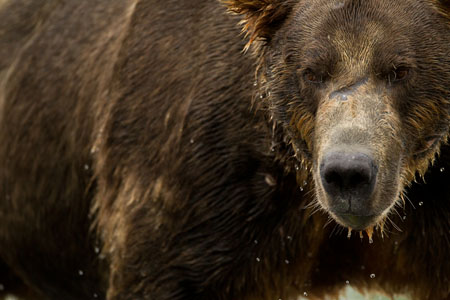
See the PDF Portfolios for both trips for more images
For years we've been visiting coastal Katmai National Park, doing so every two years, to photograph the most accessible and exciting bears in North America. Brown Bears, Ursus arctos, are grizzly bears, or vice versa, the largest land carnivore/omnivore in the western half of the continent. Along the coast these brown bears grow large, and the Kodiak Bear, famous for its size, is merely the largest of these various races or subspecies. In contrast to the mainland grizzlies, the often bleached blond bears one sees at Denali or the grizzled gray or dark brown bears of Yellowstone and Glacier, the coastal bears have a rich diet of protein, salmon, which spawn every summer and fall in the many feeder streams that snake into bays sculpting the shores of the Shelikof Bay.
Our trips are timed to, hopefully, coincide with the salmon runs, when brown bears by the dozens congregate along the shallow streams to chase down and capture salmon. Few nature spectacles in North America are as exciting for a photographer as a huge bear charges through the shallows straight towards you, water splashing everywhere, sometimes completely obscurring a bear as it dives in, paws and claws stretched out widely, to snatch at a salmon.
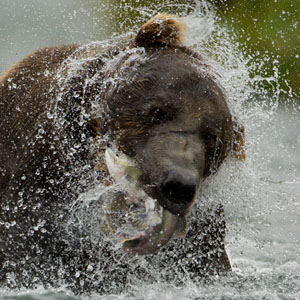
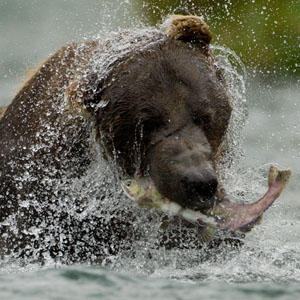
This year, we were again lucky with the salmon run, and our first trip began as some of the very first fish of the season fought their way upstream. The bears were hungry, and there were many. Here are the details:
Day 1
Our tour started in Anchorage where three of our whale participants, Bill, Rich, and Jerome, stayed over for the next trip, to Katmai for bears. Everyone met at 4AM in the hotel lobby for an early flight to Kodiak, and fortunately the transfer, check in, and boarding went flawlessly. Two seaplanes ferried us out to our boat, the Coastal Explorer, and after a late lunch we were ready for our first shore excursion. The tide was out, and several bears were visible on the beach.
Because of the afternoon light we headed to the western side of the river courses and upon landing discovered that in the 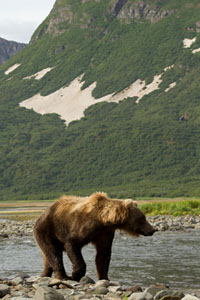 two years since our last visit the stream channels had changed. We landed near a bear and two year old cub who ignored us as they fed upon grasses, eventually foraging close enough for very good shots of the two. Eventually they moved by and upriver, and once they passed from sight we followed them, working our way upstream to a spot that gave us a nice overview of the stream.
two years since our last visit the stream channels had changed. We landed near a bear and two year old cub who ignored us as they fed upon grasses, eventually foraging close enough for very good shots of the two. Eventually they moved by and upriver, and once they passed from sight we followed them, working our way upstream to a spot that gave us a nice overview of the stream.
It was a good shoot, with bears chasing the very few salmon close by, and several circling around us to come back upstream, along the bank where we were seated before moving into a depression that functioned as an easy bear trail for the brownies to return to the stream. We had multiple chases and, upriver, we spotted a few successful bears but for most it was just a hungry exercise of patrolling the river, waiting for the salmon.
We returned by 7PM to a huge dinner by our cook, Sherry, who prepares wholesome, huge meals. This one was a beef roast, cooked slow and moist and tender enough to be parted with a fork. Everyone was exhausted from the early morning flight and a full shooting afternoon, and all retired early. Bill shot about 40 gigs, as did I, although that evening, using Breeze Browser as a first culler, I deleted about 24 gbs, leaving 17 or so that will need a much closer look.
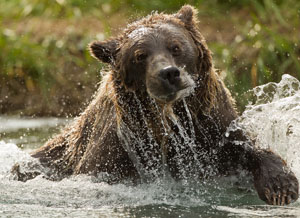
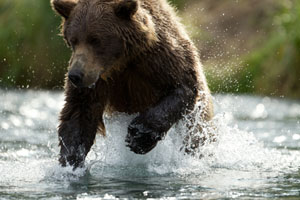
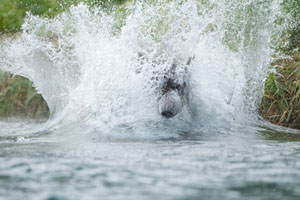
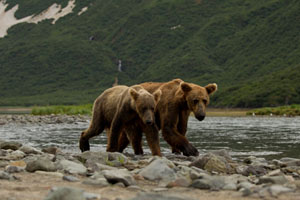
Day 2.
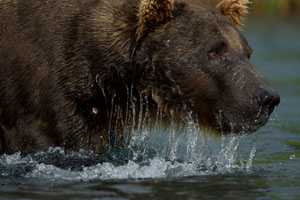 The tide was out when we awoke and as many as 18 bears were in sight feeding along the tidal flats. By 8:30 we were on the flats as well, and as a group we slowly worked several bears, beginning with a distinctive male with a twisted snout we call Balou, after the Jungle Book character, and as he wandered off we switched to a mother and 2 year old cub. They ignored us as they foraged closer, giving us very good chances at the clamming behavior bears normally do earlier in the year, before the salmon arrive. Balou returned, prompting the cub to hug against its mother, its eyes showing white as it looked sideways at this potentially lethal beach mate.
The tide was out when we awoke and as many as 18 bears were in sight feeding along the tidal flats. By 8:30 we were on the flats as well, and as a group we slowly worked several bears, beginning with a distinctive male with a twisted snout we call Balou, after the Jungle Book character, and as he wandered off we switched to a mother and 2 year old cub. They ignored us as they foraged closer, giving us very good chances at the clamming behavior bears normally do earlier in the year, before the salmon arrive. Balou returned, prompting the cub to hug against its mother, its eyes showing white as it looked sideways at this potentially lethal beach mate.
When a few bears began to gather at the river we moved upstream and for the next four hours we had a spectacular shoot as bears continuing passed by, and many catching the salmon that were beginning to run the river. One bear passed along side us and decided to sit down, facing away from us and to the river and almost minimum 500mm distance, and stayed that way, watching another bear on the other side, for five minutes or more.
Two different mothers with cubs appeared, with one clearly dominating most of the other bears as she did not give ground when another bear approached, although her cub would huddle behind her whenever a boar came near. At one point one large black griz charged downriver chasing a salmon, and the sow and cub started racing upriver towards him. She grabbed the first fish and ran to shore, with the other bear paying no attention to the fish she carried, but catching his/her own a moment later.
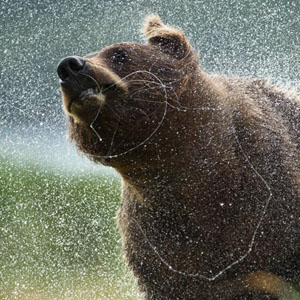 Three human observers sat behind us for much of the morning, with a laptop, note pads, and scopes, and Chuck, our Captain, said they were doing a study on ‘human/bear interactions.’ I suspected as much, and Mary and I just hoped that their ‘research’ wasn’t to prove a point of view, that photographers were impacting upon the bears. We certainly were not, as bears passed close by, rested, and even brought their cubs close as they slept, but you never know how someone collecting data sees things, or if they have an agenda.
Three human observers sat behind us for much of the morning, with a laptop, note pads, and scopes, and Chuck, our Captain, said they were doing a study on ‘human/bear interactions.’ I suspected as much, and Mary and I just hoped that their ‘research’ wasn’t to prove a point of view, that photographers were impacting upon the bears. We certainly were not, as bears passed close by, rested, and even brought their cubs close as they slept, but you never know how someone collecting data sees things, or if they have an agenda.
PM. High tide rolled in at around 2, but the tide was still up and high at 4PM when we headed back to the beach. It was crowded this afternoon, as Chuck’s companion boat, anchored against our’s, had their six participants on the beach, and a flight-seeing floatplane brought six passengers, and, for a while, the three researchers were still sitting on the beach. Ironically, it was our companion boat’s passengers that proved the most troublesome, as they changed positions several times, ending up almost directly across from our lenses on another side of the stream. Several times, as bears chased one another or 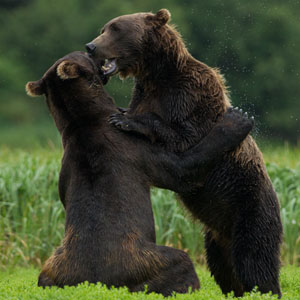 charged after salmon these tourists bright red jackets glared in to view. It was annoying, for unlike the day trippers that sometimes fly in these folks were out as long as we were, and I found shots compromised more times than I’d have cared for.
charged after salmon these tourists bright red jackets glared in to view. It was annoying, for unlike the day trippers that sometimes fly in these folks were out as long as we were, and I found shots compromised more times than I’d have cared for.
Nonetheless, the bears were good. Because of the other people on the beach we decided to stay on the side where everyone else was (initially) so as to lessen the chance of squeezing or stressing the bears, and to stay out of each other’s field of view. This eastern side faces into the afternoon light, which provided some nice backlighting and tremendous splashes – and potential clipping – as the bears chased salmon. There was a lot of action, with bears coming in from the tall grasses behind us, as well as from upriver and from the bay. By 7PM the light had begun to fail and the tide was out, and with less water volume filling the streams the salmon run, which has now definitely began, had apparently stopped for the day. As we walked across the tidal flats to water deep enough for our skiff we passed the mother bear and cub we filmed on the mud flats this morning, and another, very pretty silver bear that resembled a lower 48 grizzly that paid us no attention. Ironically, in our hike back we passed closer to the bears than we had when attempting to photograph them this morning.
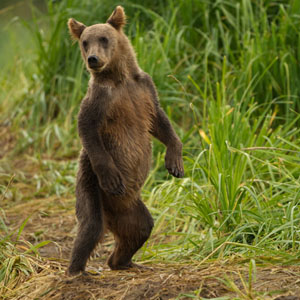
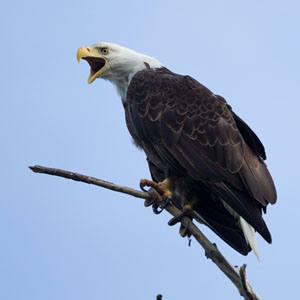
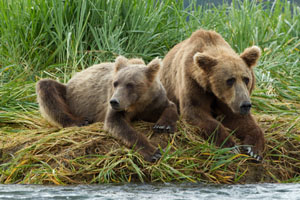
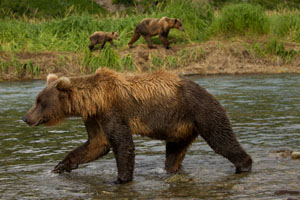
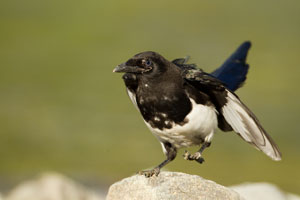
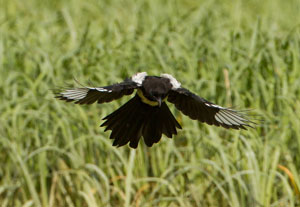
Day 3
It showered overnight and the skies were overcast at first light and, as we suited up to head back to the beaches it began to rain. We kept with our plan, landing on a virtually bear-free low tide beach and hiked the third of a mile in to our spot. Bears soon appeared and the light drizzle abated, and the shoot ended up to be quite good.
Scar-face, a big male with a distinctive slash across his snout, performed wonderfully right in front of us, snorkeling beneath the river water to watch for salmon swimming upstream. Periodically he’d rise, whale-like, in a swirl of froth and splashes, and often clomp about where either his rear-end or his paws would trap a fish. On occasion the bear would bring a salmon ashore quite close to us, and once, so close to me that I had nothing but bear paws and a rapidly disappearing salmon.
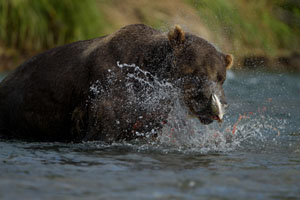
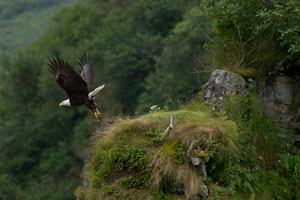
The tide came back in, with a scheduled high tide at 2, and Chuck wanted to use the tide to fill the water tanks at a fresh water outlet. We left the beach around 1, with the last of the bears disappearing from the tidal flats. After a heavy lunch, theoretically our main meal of the day, we headed up the bay in the skiff to look for eagles, and did quite well with several adults. With a very high tide, the eagle hunt was a great way to utilize the afternoon, and it worked.
Day 4
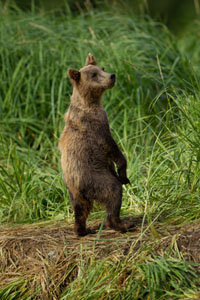
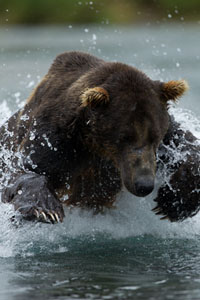
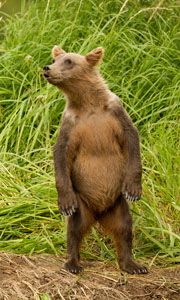
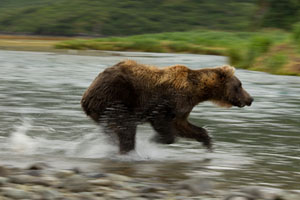
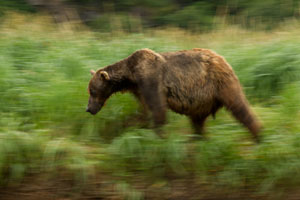
The tide schedule dictates our schedule, and today we did not plan to beach until 9:30AM but a private yacht and a rival bear-touring boat were in our harbor and we departed 40 minutes earlier. The tide was out and we had a third of a mile walk through the mudflats, but when we arrived at our viewing area Scarface, the big male bear, soon appeared and performed. We had great activity throughout the day, with two mothers with a cub passing by, and several males.
The ‘researchers’ appeared, with the monitoring professor anchored out in the bay at the entrance to the stream, and the two college girls sitting a short distance behind us. As we grew closer to leaving I stopped over to talk, and our suspicions 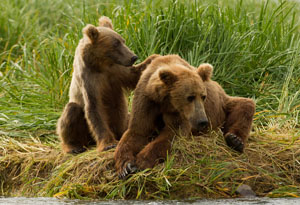 about their research was confirmed. One of the girls was doing her master’s thesis on an environmental major, and her working hypothesis was on the impact tourists had on these coastal bears. It appeared as if she had a preconceived belief that tourists, or bear-viewers, impacted upon the bears, and undoubtedly her research would confirm this. True or not. We noticed that her professor, anchored in the bay, pulled up a video camera each time a bear passed near us, documenting the interaction.
about their research was confirmed. One of the girls was doing her master’s thesis on an environmental major, and her working hypothesis was on the impact tourists had on these coastal bears. It appeared as if she had a preconceived belief that tourists, or bear-viewers, impacted upon the bears, and undoubtedly her research would confirm this. True or not. We noticed that her professor, anchored in the bay, pulled up a video camera each time a bear passed near us, documenting the interaction.
At lunch our group discussed this research at length, and Rich, who has a tremendous amount of experience with data crunching as an industrial scientist pointed out the obvious flaws in such a study. For example, we had one bear catch a salmon right in front of us but instead of coming to our shore the bear walked across the stream to feed upon the other side. We suspect that this would be recorded as impacting the bear, changing their behavior, but there is no control that definitively states that the bear would have fed on the nearer side of the stream even if we were not there. Had another bear been present the bear probably would have done the same behavior. Who knows?
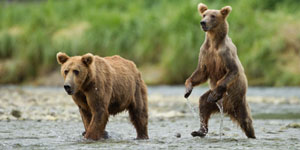 Any behavioral change, a swerve in a walk or a move from one side of the stream to another, does not necessarily mean that change is harmful, although if such a behavior was recorded as a data point it could be inferred, or interpreted, as such. I’d have love to see this college girl’s thesis read something like this: “Bear/Tourist Interactions, and the role bear tourism plays in the local Alaskan economy.” One of our participants believes that the monitoring professor tried to close down Brooks Falls in Katmai National Park for whatever reason, but if that is true then perhaps the prof has an agenda. If so, is he also considering the economic benefits this tourism creates, and is there a ‘cost’ to the bears for this benefit? If so, how much, and how serious is that cost? The master’s candidate did concede that sow bears with cubs and young males seem to benefit from the bear viewers, as these bears will feed closer to people while the more aggressive large males may not. Here at our bear viewing area we have some large males, but perhaps not ‘trophy size’ but whether or not these males are the largest present, or if even larger bears avoid the area, I simply don’t know. Regardless, I just worry that a study like this will have the same ramifications that a similar half-baked study had upon Florida’s Ding Darling National Wildlife Refuge on Sanibel Island, which resulted in the refuge being closed one day a week and the car route opened after sunrise each day. That policy ruined that refuge for photographers, and subsequent management decisions seem to have ruined the refuge’s wildlife viewing as well.
Any behavioral change, a swerve in a walk or a move from one side of the stream to another, does not necessarily mean that change is harmful, although if such a behavior was recorded as a data point it could be inferred, or interpreted, as such. I’d have love to see this college girl’s thesis read something like this: “Bear/Tourist Interactions, and the role bear tourism plays in the local Alaskan economy.” One of our participants believes that the monitoring professor tried to close down Brooks Falls in Katmai National Park for whatever reason, but if that is true then perhaps the prof has an agenda. If so, is he also considering the economic benefits this tourism creates, and is there a ‘cost’ to the bears for this benefit? If so, how much, and how serious is that cost? The master’s candidate did concede that sow bears with cubs and young males seem to benefit from the bear viewers, as these bears will feed closer to people while the more aggressive large males may not. Here at our bear viewing area we have some large males, but perhaps not ‘trophy size’ but whether or not these males are the largest present, or if even larger bears avoid the area, I simply don’t know. Regardless, I just worry that a study like this will have the same ramifications that a similar half-baked study had upon Florida’s Ding Darling National Wildlife Refuge on Sanibel Island, which resulted in the refuge being closed one day a week and the car route opened after sunrise each day. That policy ruined that refuge for photographers, and subsequent management decisions seem to have ruined the refuge’s wildlife viewing as well.
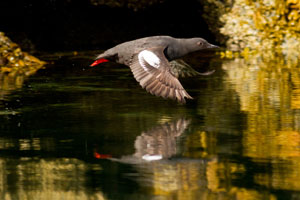
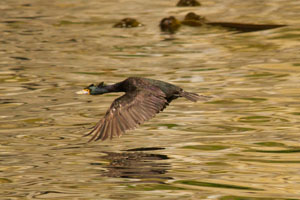
We stayed on the beach until after 2, had a huge lunch, and headed out in our ship to visit a Steller’s Sea Lion colony at the head of the bay. There were surprisingly few seals present, but plenty of Red-Faced Cormorants which we filmed there and on our return. Part way back to our anchorage most of us hopped into the skiff for another boat ride along the cliffs as we looked for more Bald Eagles. That journey was the most successful yet, as we had one immature in a picturesque nest high on a steep cliff face and, at another locale, an adult that remained perched, calling occasionally, until we finally quietly backed away.
Pigeon Guillemots, Common Murres, Black-legged Kittiwakes and Mew Gulls completed our subject list for the afternoon, on a clear, sunny day with spectacular scenics. It was a great afternoon.
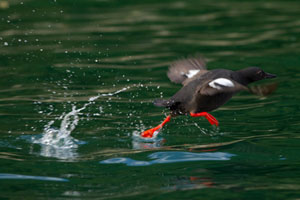
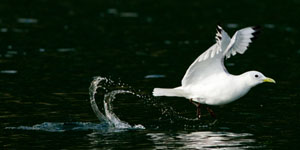
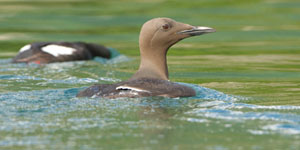
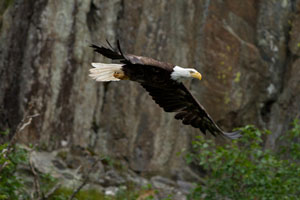
Day 5
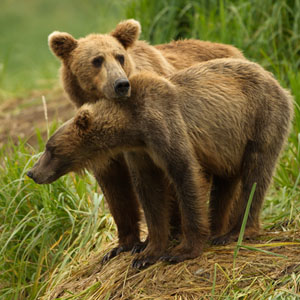
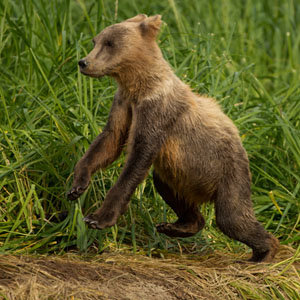
Our bear researchers were in position early, at low tide with bears scattered around the tidal mud flats. We made the beach at 9, with the tide still going out, and our walk to our viewing area was around 1400 paces, at least 6/10s of a mile, or twice the distance I figured. There were no bears at the river when we arrived, but within minutes three bears started upstream, Scarface and two other bears. We joked that the researchers should have been observing this, as it appeared that our presence had attracted the bears!
This was our last morning of the first group and we planned to be on the river until 2:30 when the oncoming tide would inundate the viewing area. While we’ve had as many as 20 bears in view from our boat, scattered around on the tidal flats, we had fewer bears today, but the shooting, and activity was constant, and it was rare that more than 10 minutes passed without another bear.
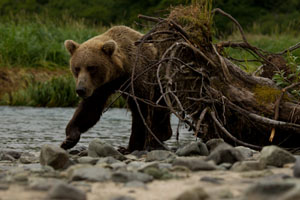 Scarface did his usual show, snorkeling with his head beneath the water to watch for salmon which, if spotted, triggered a dive or rush or bouncing, splashing chase, often resulting in a catch. A few other bears, appearing over a small rise just above the stream, would rush down and dive in, sometimes catching a fish, sometimes just bouncing about. For our last day of shooting we had some of our best luck, with bears diving headfirst into the river from the bank, and a few coming in and feeding on the shore right in front of us. One notable event occurred when a bear chased another for a few yards, then stopped, sniffed, and began a short and friendly playful wrestling match. They rose upon their hind legs and hugged, but their mouths never opened wide in the manner they adopt when play fighting. To all of us, the wrestling looked like a demonstration of affection.
Scarface did his usual show, snorkeling with his head beneath the water to watch for salmon which, if spotted, triggered a dive or rush or bouncing, splashing chase, often resulting in a catch. A few other bears, appearing over a small rise just above the stream, would rush down and dive in, sometimes catching a fish, sometimes just bouncing about. For our last day of shooting we had some of our best luck, with bears diving headfirst into the river from the bank, and a few coming in and feeding on the shore right in front of us. One notable event occurred when a bear chased another for a few yards, then stopped, sniffed, and began a short and friendly playful wrestling match. They rose upon their hind legs and hugged, but their mouths never opened wide in the manner they adopt when play fighting. To all of us, the wrestling looked like a demonstration of affection.
For all of these shoots Mary and I carried our 500mm f4 lens for our principle shooting, which often gave us full-frame face shots when bears fed close by. Mary used her 28-300 more frequently than I, and I may have been lazy as I used my very light weight 70-200 f4 lens for my closer bears. Often I wished I'd had the wider zoom, because of the animals in habitat that I missed. I never used my flash except for some people or boat cabin shots. We carried all of our gear in our Keboko backpacks, and on this first trip 7 of our 8 shooters had these light weight and very versatile backpacks.
By 2:30 the tidal flow was close to our viewing area and as we waited for the skiff we watched the tide rise, engulfing a two inch rock, prompting a comment or two. The wind had kicked up a bit and, when a group slide show scheduled for the evening, we elected to stay on board and edit. After dinner, we did a final show of everyone’s work for the week, an impressive portfolio that featured a huge variety of bear behavior, birds, and scenics.
Day 6
The skies are clear, the brightest and nicest day we’ve had yet, and our group waits for the plane that will take them back to Kodiak and their red-eye flights to home. A steady wind slowly spins our boat about, pivoting off the anchor as I finish the first bear trip report, as we wait for the next group’s arrival.
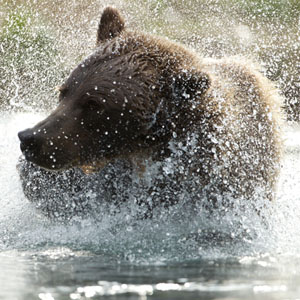
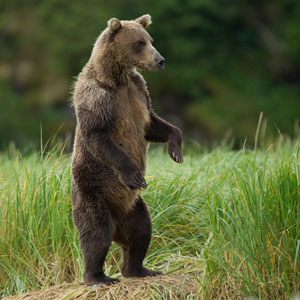
If you'd like to see our other years' various Trip Reports, and photos that help to illustrate the story, check out the Home Page and the reports listed there, or click on any of these links:


